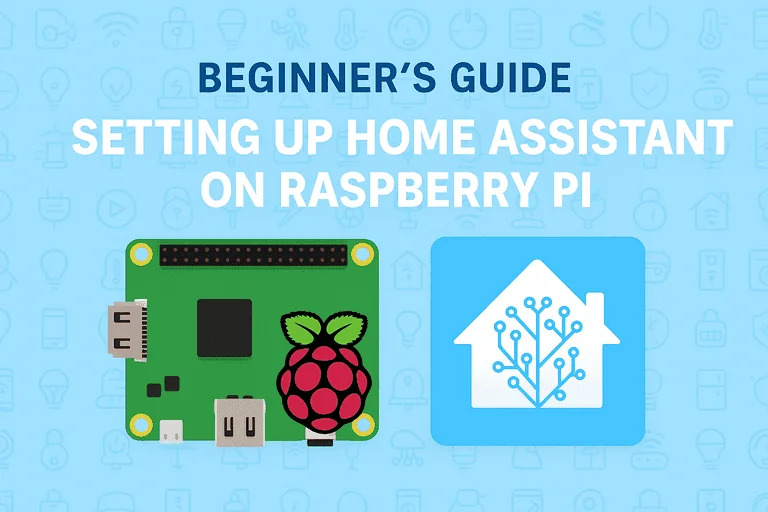Beginner’s Guide: Setting Up Home Assistant on Raspberry Pi
Introduction
Looking to control your smart home with full privacy and flexibility? Home Assistant is the go-to self-hosted platform for automating and managing smart devices without cloud dependency. In this guide, we’ll walk you through installing Home Assistant on a Raspberry Pi—ideal for beginners starting with home automation.
Who is this for?
- Beginners who want to run Home Assistant on a Raspberry Pi
- Privacy-conscious users who want local control
- Tinkerers exploring home automation
What you’ll get:
- A working Home Assistant instance on your Pi
- A local dashboard to manage your smart home
- A foundation for advanced automations later
Why Home Assistant + Raspberry Pi?
| Feature | Home Assistant on Raspberry Pi |
|---|---|
| Privacy | 100% local control, no cloud required |
| Cost | Low (Raspberry Pi + SD card) |
| Community | Large, helpful, well-documented |
| Flexibility | Supports thousands of integrations |
| Extendability | Add-ons, custom dashboards, automations |
Alternatives: OpenHAB and Domoticz are also options, but Home Assistant is more user-friendly and widely supported.
What You Need
- Raspberry Pi 4 (2GB or more recommended)
- MicroSD Card (16GB minimum, 32GB+ recommended)
- Power Supply
- Ethernet or Wi-Fi
- SD Card Reader
- Computer for flashing image
Optional:
- USB SSD (faster & more durable than SD)
- External Zigbee/Z-Wave dongles (for device control)
Step-by-Step Installation
1. Download Home Assistant OS
Go to the official Home Assistant Raspberry Pi install page and download the correct image for your Raspberry Pi model.
2. Flash the SD Card
Use Balena Etcher or Raspberry Pi Imager to flash the Home Assistant OS image to your SD card. It’s a simple 3-step process:
- Select image
- Select SD card
- Flash
3. Insert and Boot
Place the SD card into your Pi, connect it to the network (Ethernet recommended), and power it on. Wait 20–30 minutes for the initial boot.
4. Access the Web Interface
Open a browser and go to http://homeassistant.local:8123 or find your Pi’s IP in your router (e.g., http://192.168.1.123:8123).
Troubleshooting Tip: Can’t access it? Use a tool like Fing to find devices on your network.
5. Set Up Home Assistant
Follow the onboarding wizard:
- Create an admin user
- Set location/timezone
- Choose basic integrations (like energy monitoring)
Congrats, you’re in!
Key Concepts for Beginners
Entities & Devices
Home Assistant organizes smart devices as entities. A smart bulb may have entities like light.bedroom, sensor.temperature.
Integrations
These connect Home Assistant to your smart devices. Examples:
- Philips Hue
- MQTT
- Sonoff
- Google Cast
Automations
Automations follow logic like:
If motion is detected and it’s after sunset → turn on hallway light.
You can write these in YAML or use the visual editor.
Advanced Setup Ideas (Optional)
Ideal once you’re comfortable with the basics.
Add HACS (Home Assistant Community Store)
HACS lets you install third-party integrations and custom cards easily.
- Visit https://hacs.xyz
- Follow install instructions via SSH
Install Add-ons
Home Assistant OS supports built-in Add-ons:
- File Editor
- Samba Share (for accessing config files)
- Mosquitto MQTT
- Node-RED
Secure with HTTPS
Set up DuckDNS + Let’s Encrypt or reverse proxy with NGINX for remote access over HTTPS.
Performance Tips
- Use SSD boot for improved speed and reliability
- Keep the SD card backed up (e.g., via snapshot)
- Disable unused integrations
- Use MQTT for low-latency IoT devices
Comparison with Cloud-Based Solutions
| Feature | Home Assistant | Google Home / Alexa |
| Data Privacy | Fully local | Cloud-based, data shared |
| Customization | High | Limited |
| Offline Functionality | Full | Limited or none |
| Voice Assistant Support | Yes (via integrations) | Native |
FAQs
Q: Can I use a Raspberry Pi 3?
A: Yes, but performance may lag with many integrations.
Q: Can I access it remotely?
A: Yes, via VPN, Nabu Casa (paid), or reverse proxy.
Q: Is Home Assistant free?
A: 100%. Optional features like Nabu Casa cost extra but support development.
Final Thoughts
Home Assistant is one of the most rewarding open-source projects for privacy-first home automation. With a Raspberry Pi, a bit of patience, and this guide, you’re already ahead of the curve.
Ready to take control? Fire up your Pi, and make your home smarter—your way.
Support SelfhostHero: Enjoy this guide? Share it, or consider using our affiliate links for hardware—you support independent content like this

